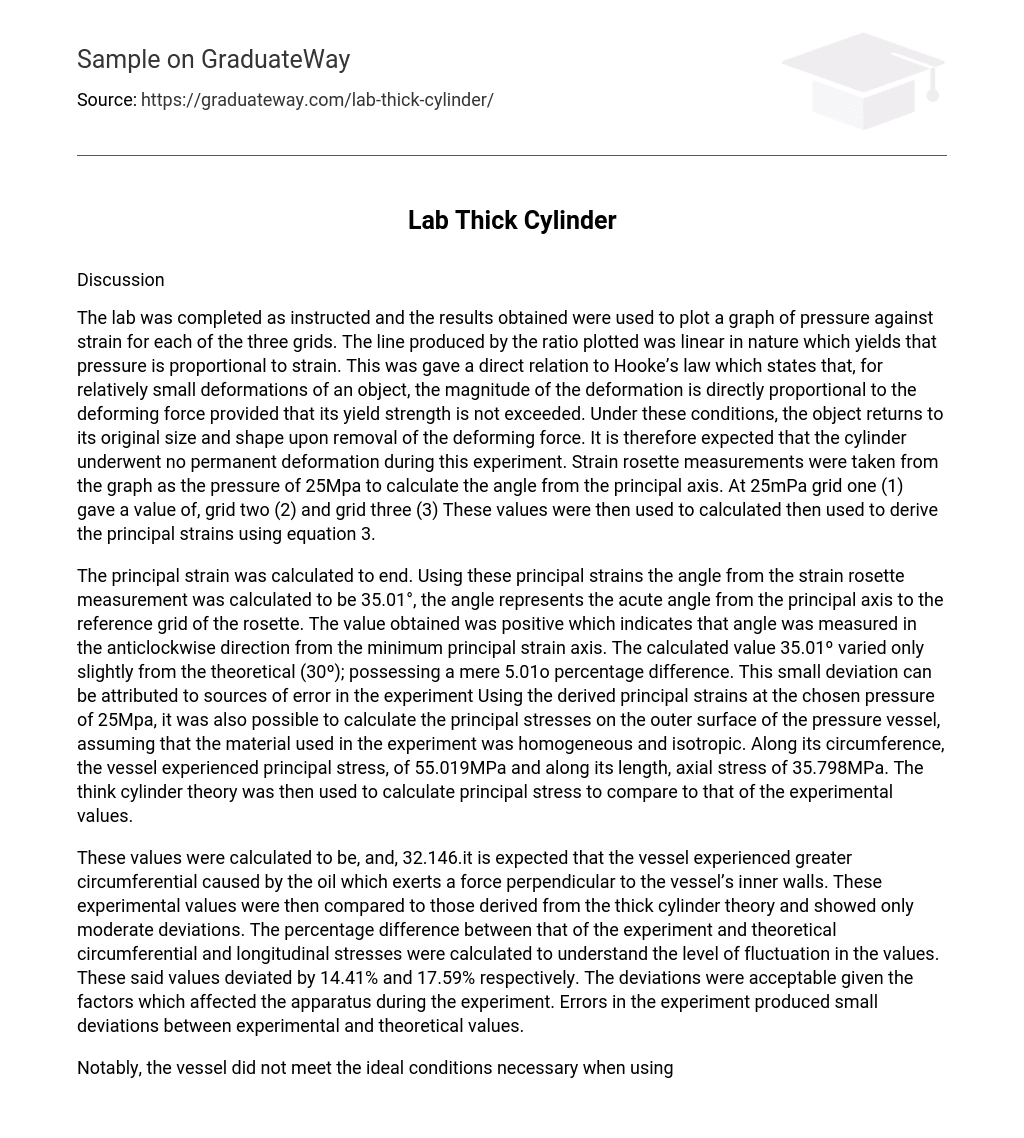Discussion
The lab was completed as instructed and the results obtained were used to plot a graph of pressure against strain for each of the three grids. The line produced by the ratio plotted was linear in nature which yields that pressure is proportional to strain. This was gave a direct relation to Hooke’s law which states that, for relatively small deformations of an object, the magnitude of the deformation is directly proportional to the deforming force provided that its yield strength is not exceeded. Under these conditions, the object returns to its original size and shape upon removal of the deforming force. It is therefore expected that the cylinder underwent no permanent deformation during this experiment. Strain rosette measurements were taken from the graph as the pressure of 25Mpa to calculate the angle from the principal axis. At 25mPa grid one (1) gave a value of, grid two (2) and grid three (3) These values were then used to calculated then used to derive the principal strains using equation 3.
The principal strain was calculated to end. Using these principal strains the angle from the strain rosette measurement was calculated to be 35.01°, the angle represents the acute angle from the principal axis to the reference grid of the rosette. The value obtained was positive which indicates that angle was measured in the anticlockwise direction from the minimum principal strain axis. The calculated value 35.01º varied only slightly from the theoretical (30º); possessing a mere 5.01o percentage difference. This small deviation can be attributed to sources of error in the experiment Using the derived principal strains at the chosen pressure of 25Mpa, it was also possible to calculate the principal stresses on the outer surface of the pressure vessel, assuming that the material used in the experiment was homogeneous and isotropic. Along its circumference, the vessel experienced principal stress, of 55.019MPa and along its length, axial stress of 35.798MPa. The think cylinder theory was then used to calculate principal stress to compare to that of the experimental values.
These values were calculated to be, and, 32.146.it is expected that the vessel experienced greater circumferential caused by the oil which exerts a force perpendicular to the vessel’s inner walls. These experimental values were then compared to those derived from the thick cylinder theory and showed only moderate deviations. The percentage difference between that of the experiment and theoretical circumferential and longitudinal stresses were calculated to understand the level of fluctuation in the values. These said values deviated by 14.41% and 17.59% respectively. The deviations were acceptable given the factors which affected the apparatus during the experiment. Errors in the experiment produced small deviations between experimental and theoretical values.
Notably, the vessel did not meet the ideal conditions necessary when using equations 5 and 6 to derive principal stresses; homogeneous and isotropic vessel material. Faulty seals may have caused the axial stress to have a greater percentage error; since the experiment requires closed-end integral with the cylinder. Wear might have also had an effect on the vessel sealing; pockets of air in the vessel would mean the oil is not evenly pressurized along the vessel walls One completion of the lab there was a couple of source of error that might have attributed to the level of deviation in the values. Reading the indicated strain could have generated an error in this lab since the values were fluctuating. Another source of error could have resulted from damage wire which could have affected the readings.
Repeated use may have contributed to permanent deformation; altering the specification of the apparatus mainly the radii and thus the soundness of values derived from equations 7 and 8. Additionally, these equations are valid for a vessel subject only to internal pressure; atmospheric pressure creates conditions that do not parallel the ideal and induces error. Work-hardening is also likely and may cause the vessel’s material to behave differently under stress; material properties such as modulus of elasticity (E) and Poisson’s ratio (v) may be altered. Finally, the strain measurement apparatus was very sensitive and provided fluctuating readings and as is the case with all electrical equipment wire resistance, power loss and an improper grounding must also be considered as possible sources of derivation. This experiment could have improved by ensuring the wiring on the test apparatus is properly intact and the apparatus is properly grounded because if the connections are disturbed, it can cause a resistance between the plugs and the sockets to be altered which could cause an offset to the initial bridge balance.
Conclusion
The aim of this experiment was met. The stress-strain relationship on the outer surface of a thick wall pressure vessel by the use of strain gauges in determining principal strain and stresses was investigated. As shown in the Graph the stress-strain relationship on the outer surface of a thick wall pressure vessel is one of direct proportionality. The use of strain gauge rosettes was pivotal to the determination of this relationship; they were used to measure the principal strains from which the principal stresses and rosette orientation were derived.
References
- Ayob, A. B., Tamin, M. N. & M. Kabashi Elbasheer, ‘Pressure Limits of Thick-Walled Cylinders’, Proceedings of the International MutiConference of Engineers and Computer Scientists 2009 Vol. II, IMECS: 2009, March 18, Hong Kong.
- J. M. Kihiu, S. M. Mutuli & G. O. Rading, n. d.,Stress characterization of autofrettaged thick-walled cylinders, pp. 370, International Journal of Mechanical Engineering Education, 31/4, Department of Mechanical Engineering, University of Nairobi.
- P. P., Benham, R. J., Crawford & C. G., Armstrong, 1996, ‘Chapter 14 – Applications of the Equilibrium and Strain-Displacement Relationships’, in Mechanics of Engineering Materials, 2ndedn., Pearson Longman, China





